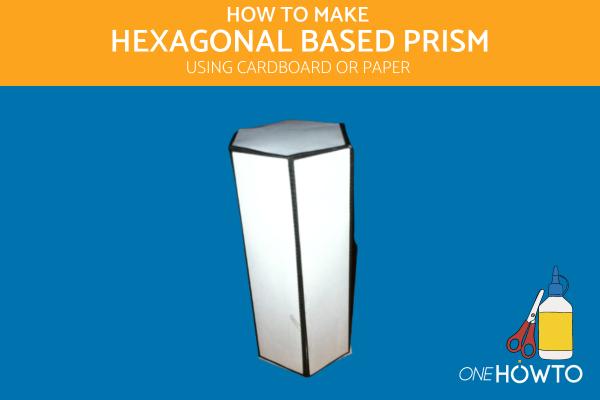How to Make a Hexagonal Based Prism With Paper or Cardboard


A prism is a three-dimensional geometric shape that has two identical and parallel polygonal bases connected by rectangular or parallelogram-shaped side faces. In the case of a hexagonal-based prism, the base is a hexagon (a polygon with six sides), and the side faces are parallelograms. Making a hexagonal-based prism with cardboard can be a great DIY project.
In this article from oneHOWTO, we'll guide you through the simple steps of making a hexagonal based prism out of cardboard and give you some tips and tricks along the way.
You'll need:
- Template
- Scissors
- Tape or glue
- Paper or cardboard
- Pencil
Steps to follow:
To create a hexagonal-based prism using cardboard, the initial step is to draw a template of the prism on a piece of paper or cardboard. This template will serve as a guide for cutting and assembling the cardboard pieces. By accurately copying the shape of the prism onto the paper or cardboard, you can ensure that the subsequent steps in constructing the hexagonal-based prism are carried out correctly.

After drawing the template of the hexagonal-based prism on the paper or cardboard, the next step is to carefully cut out the prism shape using a pair of scissors.
Take your time to follow the lines of the template accurately, ensuring smooth and precise cuts. This will provide you with the individual pieces needed to assemble the prism. Be cautious while cutting to avoid any accidental injuries and maintain the integrity of the template.

Once you have cut out the prism template, the next step is to fold along all the lines indicated on the template. Gently crease each fold to make it easier to assemble the prism later on.
Before applying any glue, it is recommended to test-fit the pieces together to ensure proper alignment and positioning of each tab. By doing so, you can verify the correct orientation of the sides and tabs, allowing for adjustments if needed.

After folding the cut-out along the designated lines, it's time to start assembling the hexagonal-based prism. Begin by applying glue to one of the tabs on the template. Carefully align the tab with its corresponding side and press it firmly with your fingers to secure it in place.
Make sure the edges are well-bonded. Repeat this process for the remaining tabs, one by one, applying glue and pressing them down firmly to ensure a strong bond. Take your time and ensure each tab is securely glued to its adjacent side.

Congratulations! You have successfully created your hexagonal-based prism using cardboard. This is just one of the many fascinating 3D shapes you can make. If you're interested in exploring more, check out other tutorials at oneHOWTO where you can learn how to create other impressive shapes like a cube, a pyramid, or even a cylinder.

If you want to read similar articles to How to Make a Hexagonal Based Prism With Paper or Cardboard, we recommend you visit our Art & handicraft category.
Tips
- If you are not a good drawer, copy the image of the template and paste it into a word document. Make it as big as you want and then print.
- You can make your hexagonal based prism with coloured cardboard. Choose which you like best!
- I recommend that before you start gluing you try to put it together to ensure it fits. Once you are sure it will all fit together start putting glue onto the folds and sticking them down. Do this for all the folds.









